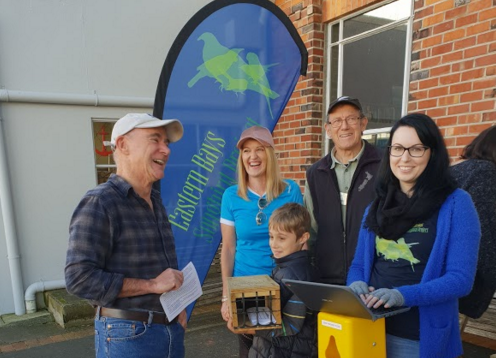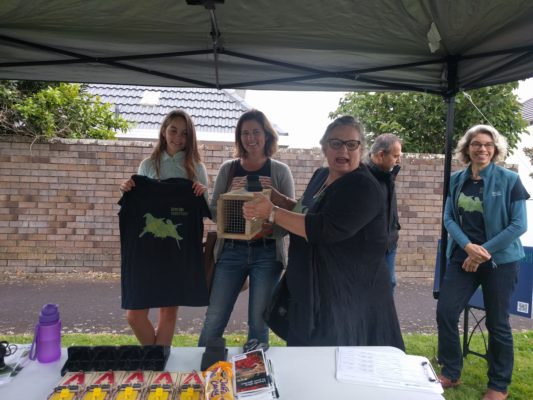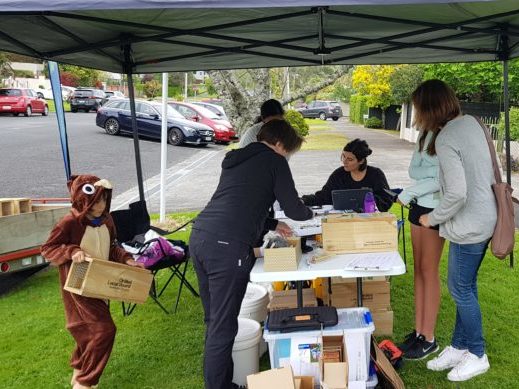Five Auckland suburbs, 16,000 households – if you think it sounds like an ambitious trapping project, you’re not far wrong. Innovative ideas, funding support and well thought out planning are all going to be crucial in the months and years ahead for the Eastern Bays Songbird Project.
The backyard component of the trapping programme is being supported by Kiwibank and Predator Free NZ Trust. So how has their first year gone?

“We’ve handed out 620 rat traps and 180 possum traps so far across the whole area,” says Dr Julie Robson, consultant and manager of the project. “We’re aiming to bring together existing trapping groups in the reserves, with our Kiwibank Predator Free Community funding targeted to a specific area – backyards around the Churchill Park area.”
The volunteer team have tested several ways for getting traps out into the community and come up with a method that’s working well for them.
“We flyered the neighbourhood first then had a trap handout in the targeted zone,” says Julie. “We handed out a pretty good number – about 50 traps in a day. We also have a team of postgraduate students who are members of the Songbird Project and they support trappers through emails, chats and phone calls. We give away snap traps and tunnels in the zone and sell Goodnature traps at a discounted rate.”
Eastern Bays Songbird Project has teamed up with their local Menz Shed in East Auckland to source the trap tunnels.
“Alan Minson, who runs the Menz Shed, is also one of our committee members and a trapper,” says Julie. “The Menz Shed started making trap tunnels for the Songbird Project and now they’re supplying others as well. It’s a really nice partnership,” she adds, “and great to keep the money in a social enterprise base.”

Auckland Council is also supporting the Songbird Project and has supplied rat and possum traps.
“We’re developing an aim to make the whole area possum free,” says Julie, while admitting it’s something of a ‘stretch target’ for the group. The Ōrākei Local Board has been amazing too and funded personnel. I’m contracted for 15 hours a week and there are four others including our biosecurity students. I think of the students as early career conservationists and I’m keen to bring them on,” Julie says. “They’re amazing – a Godsend – full of good ideas!”
Julie and her student team have been testing different methods for getting their neighbourhood trappers to report back results.
“There’s a steady trickle of results, but reporting is a bit of a sticking point,” Julie says. “We’ve tried an email form with ‘trap number’ and ‘what caught’ and we’ve tried using texts. Another idea we’re trying is a ‘Trap Catch Record’ which is a pretty form people put on their fridge and write all their catches down on, then they can photograph the record and send it in.”
All collected results are added to the CatchIT database developed by Auckland University.
“Other types of monitoring will be more important for us, Julie says”
Birds, predators and vegetation changes are all monitored by the Songbird Project volunteers and their support organisations.
“We do two bird counts per year and Auckland Council monitor with tracking tunnels,” says Julie. “We also do ‘Photopoint’ monitoring where we take a photo of an area at regular intervals, accompanied by a framework to make sure the area included in the photograph is always exactly the same. It’s a way to monitor changes in vegetation and to see if the removal of possums is leading to changes.”

In the longer term the Eastern Bays Songbird Project is aiming to get one trap in every 5th household.
“That’s 4000 rat traps,” says Julie, “It’s a lot! We’re also looking to expand what we do to include running events to connect the community to the place. We’re talking to Auckland Council about doing guided walks for example.”
Julie hopes it will encourage people to care and want to help.
“I believe that the more appreciative and in awe of the environment people are then the more they will want to protect it,” she says. “We’re also responding to the community on that. At the trap handout people were asking what they could do to improve their garden, what they can plant, what else they can do?”
Residents are already commenting on the increased number of birds they are seeing. We hope to begin rewarding our trappers with native plants for their gardens next year.
Songbird Project volunteers have been encouraged by how supportive the Eastern Bays community is about becoming predator free.
“We thought we might have to explain about predator control, but it hasn’t been an issue,” says Julie. “People know what we’re doing and why and they’re ready to get on with it. My aim is to make trapping part of the normal practice of managing your home,” she adds. “I want rat trapping to be something that Kiwis just do!”

